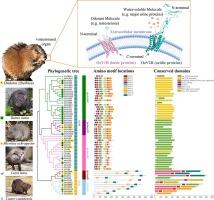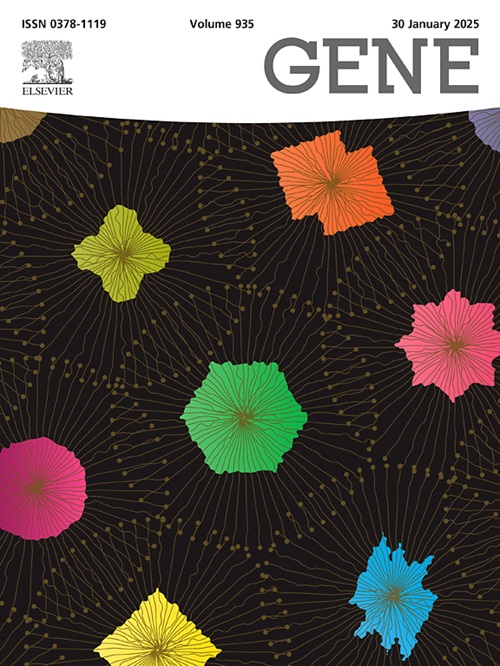雌性麝鼠(Ondatra zibethicus)绒毛膜受体的特征和系统发育分析
IF 2.6
3区 生物学
Q2 GENETICS & HEREDITY
引用次数: 0
摘要
绒毛鼻腔受体(VRs)在识别信息素方面发挥着至关重要的作用,而信息素是社会化学交流的关键。雄性麝鼠(Ondatra zibethicus)会分泌含有信息素的麝香作为生殖信号,雌性麝鼠可以通过绒毛膜促性腺激素受体(VNO)识别麝香,从而介导社会交流行为。本研究旨在鉴定雌性麝鼠VRs(OzVRs)的基因组信息,并阐明其理化性质和进化关系。利用RACE技术鉴定了6个主要表达的OzVR基因,并对其基因结构、亚细胞分布、功能预测和mRNA水平进行了综合分析,结果显示所有OzVR均为跨膜蛋白。系统发生分析将 OzVR 基因分为两个支系(V1Rs:OzV1R21、OzV1R81、OzV1R105;V2Rs:OzV2R33、OzV2R44、OzV2R60)。从生化角度看,OzV1Rs 是碱性蛋白质,而 OzV2Rs 则呈弱酸性。其中,OzV1R81 和 OzV2R44 被鉴定为疏水性稳定蛋白,其余被归类为疏水性不稳定蛋白。启动子分析表明,转录因子和复合物(包括 Ahr::Arnt、Runx1、Arnt 和 TFAP2A)参与了 OzVR 基因的表达调控。保守结构域和主题分析表明,啮齿类动物中的VRs超家族具有高度的保守性,其中许多保守结构域与信息素结合有关。功能预测证实,OzVRs与信息素检测有关。最后,OzVR基因在不同组织和季节的表达模式表明,OzVRs在绒毛器官中的表达水平最高,OzV1Rs在繁殖季节的表达水平明显高于非繁殖季节,但OzV2Rs在非繁殖季节的表达水平较高。本研究对OzVRs的系统发育关系、基因结构、理化性质、启动子结合位点、功能和基因表达模式进行了深入研究,为进一步研究VR基因功能提供了理论参考,为了解麝鼠的化学信号转导机制奠定了基础。本文章由计算机程序翻译,如有差异,请以英文原文为准。

Characterization and phylogenetic analysis of vomeronasal receptors in the female muskrat (Ondatra zibethicus)
Vomeronasal receptors (VRs) play a crucial role in recognizing pheromones, which are essential for social chemical communication. The male muskrat (Ondatra zibethicus) secretes musk, which contains pheromones as a reproductive signal, and the female can recognize it through the VNO to mediate social communication behavior. This study aimed to identify the genomic information of VRs (OzVRs) in the female muskrat and elucidate their physicochemical properties and evolutionary relationship. Six predominantly expressed OzVR genes were identified using the RACE technique, and a comprehensive analysis was conducted on their gene structure, subcellular distribution, functional predictions, and mRNA levels, revealed that all OzVRs were transmembrane proteins. Phylogenetic analysis clustered OzVR genes into two clades (V1Rs: OzV1R21, OzV1R81, OzV1R105; V2Rs: OzV2R33, OzV2R44, OzV2R60). Physiochemically, OzV1Rs were basic proteins, while OzV2Rs exhibited weakly acidic character. Among them, OzV1R81 and OzV2R44 were identified as hydrophobicitystable proteins, with the remainder categorized as hydrophobicity-unstable proteins. Promoters analysis revealed the involvement of transcription factors and complexes, including Ahr::Arnt, Runx1, Arnt, and TFAP2A, in regulating the expression of the OzVR genes. Conserved domain and motif analyses demonstrated a high conservation of the VRs superfamily in rodents, with many conserved domains linked to pheromone binding. Functional predictions confirmed that OzVRs were associated with pheromones detection. Finally, the expression patterns of OzVR genes in different tissues and seasons indicated that OzVRs have the highest level of expression in the vomeronasal organ, and OzV1Rs notably higher in the breeding season than that in the non-breeding season, however the expression levels of OzV2Rs were higher in the non-breeding season. This study provided insights into the phylogenetic relationships, gene structure, physicochemical properties, promoter binding sites, functions and gene expression patterns of OzVRs, offering a theoretical reference for further examination of VR gene functions and a foundation for understanding chemical signaling mechanisms in the muskrat.
求助全文
通过发布文献求助,成功后即可免费获取论文全文。
去求助
来源期刊

Gene
生物-遗传学
CiteScore
6.10
自引率
2.90%
发文量
718
审稿时长
42 days
期刊介绍:
Gene publishes papers that focus on the regulation, expression, function and evolution of genes in all biological contexts, including all prokaryotic and eukaryotic organisms, as well as viruses.
 求助内容:
求助内容: 应助结果提醒方式:
应助结果提醒方式:


